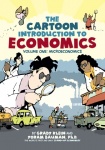
The Cartoon Introduction to Economics: Vol.1 Microeconomics
Publisher: Hill & Wang
Release Date: February 1, 2010
Price: $17.95
Creators: Yoram Bauman & Grady Klein
Page Count: 212 pages
Format: Trade Paperback, B&W
ISBN: 978-0-8090-9481-3
Age Rating: Unrated
ICv2 Rating: 3.5 Stars out of 5
Grady Klein and Yoram Bauman’s Cartoon Introduction to Economics provides readers with a surprisingly sophisticated survey of many of the primary currents of thought in modern economics. The authors do a very good job of explaining the theories that underlie free market economics, clearly explicating the intricacies of supply and demand, the “tragedy of the commons,” game theory, Pareto Efficiency, auction theory and much more. This volume is primarily useful for those who are studying economic theory, but anyone who wants a basic understanding of economics or to calculate the value or usefulness of an annuity will find the principles contained here very helpful.
The emphasis in this volume is on understanding the basic principles of the “dismal science,” which are explained cleverly in theoretical examples. The humor comes courtesy of writer Yoram Bauman, a Ph.D. in economics who is also a stand-up comedian. Cartoonist Grady Klein (creator of The Lost Colony, published by First Second) supplies the art. In comparison to the work of Larry Gonick, who invented the “Cartoon Guide” genre, Bauman and Klein’s volume is more conventional in its approach and in its deference to the current trends of economic thought in academia.
As is indicated in its subtitle, Vol.1 Microeconomics, The Cartoon Introduction to Economics does not cover the big picture issues like inflation, unemployment, boom and bust cycles, and economic growth. It also doesn’t explain the complex financial instruments such as credit default swaps and derivatives that helped cause the recent deep recession.
Klein and Bauman’s Cartoon Introduction to Economics steers clear of most political issues, though it does point out in discussing health care that “adverse selection” is one example of a situation where individual optimization does not lead to good outcomes for the group as a whole. While the authors are quick to point out that this “doesn’t necessarily mean that government-run health insurance will necessarily lead to a better outcome,” they do note that “every other developed country does it.”
But don’t get the wrong idea--this is no radical or socialist treatise. The emphasis throughout is on the free market and free trade. The authors are very much devotees of Adam Smith’s “invisible hand.” For intractable problems such as pollution and global warming, the authors clearly prefer free market solutions such as “cap and trade.”
--Tom Flinn, ICv2 VP-Content







